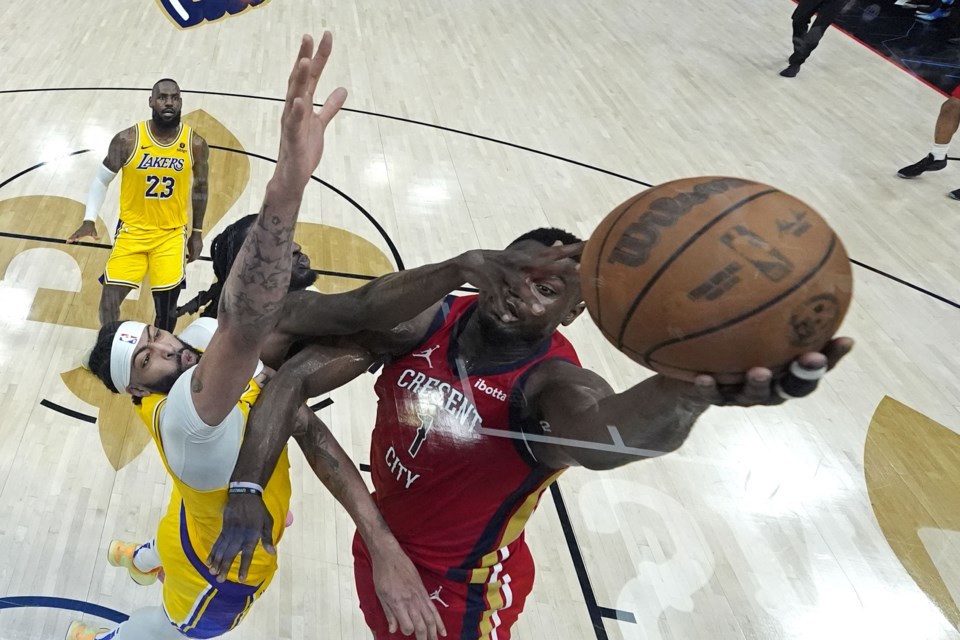NEW ORLEANS (AP) — Gerald Herbert insists on making sure he provides the best coverage possible when photographing New Orleans’ NBA team. That means laboriously hanging remote cameras in the Pelicans’ arena hours before every home game. For their game against the Lakers on April 17, Herbert got a sweet spot right behind the backboard glass. It allowed him to capture Pelicans star Zion Williamson as he goes to the basket against Anthony Davis while LeBron James watches the action. Here’s what Herbert had to say about making this extraordinary image.
WHY THIS PHOTO
Many people don’t realize how much work can go into covering a sporting event. Being based in New Orleans, the Pelicans are one of the teams I cover from beginning to end of the season. For the last 14 years, whether they are at the top of the standings or the bottom, I treat each game as both a challenge and a privilege. I always hang remote cameras because the team and the arena allow it. It is a challenge for the technical difficulties that always conspire against you and a privilege, not only to have the access for the remotes, but also to share the images with a grand audience. Lots can go wrong with remote cameras, such as your prefocus being slightly off, radio interference on your remote triggers, batteries dying, a wrong camera setting, etc. So often you have to kiss an entire game’s worth of images from that camera goodbye and just start fresh the next game.
Although I used to hang a remote camera behind the glass backboard, the real estate has become scarce, so I have been hanging two remotes: one on the stanchion (the metal structure that supports the goal) and one overhead in the rafters above. Every game I put in the extra hours to set them up and test them. It increases my workload, setting up and tending to three cameras and it slows down my edit with the extra images but, in the end, it makes my basketball report look more dynamic.
HOW I MADE THIS PHOTO
For the last few games of the season, I was granted permission to start using a remote behind the glass again. I chose to use an extremely wide lens, A Sony 12-24mm wide zoom, set at 12mm, and I have been steadfast about not going any tighter. My intent was to make my shots look different and incorporate as much of the gritty infrastructure of the basketball goal as possible: imperfect and real, something people don’t normally see. It is an experiment in progress. I don’t mind the reflections, but it seems they do eliminate a lot of the potentially great moments. If I get a few good frames from that camera in a game, I am happy.
Given that space is competitive, I set this remote up with little fuss to stay out of the way. Although photographers normally mask off the remote with black foil and tape to eliminate the reflections, I opted to leave that out for now to be as quick an inobtrusive as possible with the setup. I don’t want to overextend my welcome. When a team like the Lakers come to town, it draws a lot more media, a larger TV viewing audience, more cameras and people, less space. Things are more tense and fast moving, and the pucker factor increases exponentially, as people are on edge.
I trigger my remotes with my thumb on a button mounted on the lens barrel of my primary camera that I am hand holding. My remotes are on the far goal where I am not present to increase my chances of capturing key plays by keeping both ends of the court covered. I can’t always see what is going on downcourt, so if bodies are moving toward the basket, I hammer on the button, and wait to see what I got later during the edit. Sometimes the ones you think will be great turn out to be duds and sometimes the unexpected happens and you get lucky. It’s all in the planning, the taking of chances, and the edit.
WHY THIS PHOTO WORKS
The goal in this game was to get the key players in one dynamic frame. With Zion Williamson, LeBron James and Anthony Davis, I managed to get all three in. My only wish was if LeBron was more involved in the play. Sequentially, as Zion drove to the basket, as the players closed in, Taurean Prince’s hand went in front of Zion, and there was this one frame where he was peering through that hand. The superior frame stood out, with only one eye peering through, showing the intensity and determination. I decided to crop in tight to accentuate that. Other frames that I filed from that camera were looser, revealing much more of the court.
As my dear colleague J. Scott Applewhite likes to say: “The harder I work, the luckier I get.” An excellent credo to live by.
___
For more extraordinary AP photography, click here.
Gerald Herbert, The Associated Press



